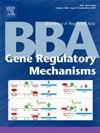PIWIL/piRNA-OTX2网络:视网膜母细胞瘤肿瘤干细胞的表观遗传调控新模型
IF 3.1
3区 生物学
Q3 BIOCHEMISTRY & MOLECULAR BIOLOGY
Biochimica et Biophysica Acta-Gene Regulatory Mechanisms
Pub Date : 2025-07-19
DOI:10.1016/j.bbagrm.2025.195106
引用次数: 0
摘要
最近的研究结果强调了PIWIL/piRNA通路在癌症中的关键作用,将其已知功能扩展到生殖生物学之外。视网膜母细胞瘤(RB)是一种罕见的儿童视网膜肿瘤,主要由RB1基因缺失驱动,但也涉及显著的表观遗传改变。我们之前的研究表明,PIWIL4在RB中显著上调,其下调会破坏OTX2、SOX2和NANOG等stemness相关因子的表达。在这篇综述中,我们提出PIWIL/piRNA复合物可能将表观遗传修饰因子募集到OTX2基因的顺式调控模块(CRMs)中,调节染色质可及性和转录因子结合。PIWIL4的异常表达可能会使OTX2的表达失调,影响干细胞维持因子,激活由TSPAN12、EphA2和ZNF蛋白介导的Wnt/β-catenin信号通路。这一概念框架将PIWIL/piRNA-OTX2轴定位为CSC动力学的潜在调节因子,将其与RB的表观遗传修饰、转录因子相互作用和神经元分化联系起来。靶向该轴可能会破坏干细胞相关通路和致癌信号,为减轻RB和其他具有类似分子机制的癌症的肿瘤进展和复发提供新的治疗策略。本文章由计算机程序翻译,如有差异,请以英文原文为准。
A putative PIWIL/piRNA–OTX2 network: An emerging model for epigenetic regulation of cancer stemness in retinoblastoma
Recent findings underscore the critical role of PIWIL/piRNA pathways in cancer, extending their known functions beyond reproductive biology. Retinoblastoma (RB), a rare pediatric retinal tumor, is primarily driven by RB1 gene loss but also involves significant epigenetic alterations. Our previous studies revealed that PIWIL4 is significantly upregulated in RB, and its knockdown disrupts the expression of stemness-associated factors, including OTX2, SOX2, and NANOG. In this review, we have proposed that PIWIL/piRNA complexes might recruit epigenetic modifiers to cis-regulatory modules (CRMs) of the OTX2 gene, modulating chromatin accessibility and transcription factor binding. Aberrant PIWIL4 expression may dysregulate OTX2 expression, impacting stemness-maintaining factors and activating oncogenic pathways, including Wnt/β-catenin signaling, mediated by TSPAN12, EphA2, and ZNF proteins. This conceptual framework positions the PIWIL/piRNA-OTX2 axis as a potential regulator of CSC dynamics, linking it to epigenetic modifications, transcription factor interactions, and neuronal differentiation in RB. Targeting this axis could disrupt stemness-associated pathways and oncogenic signaling, offering new therapeutic strategies to mitigate tumor progression and recurrence in RB and other cancers with similar molecular mechanisms.
求助全文
通过发布文献求助,成功后即可免费获取论文全文。
去求助
来源期刊
CiteScore
9.20
自引率
2.10%
发文量
63
审稿时长
44 days
期刊介绍:
BBA Gene Regulatory Mechanisms includes reports that describe novel insights into mechanisms of transcriptional, post-transcriptional and translational gene regulation. Special emphasis is placed on papers that identify epigenetic mechanisms of gene regulation, including chromatin, modification, and remodeling. This section also encompasses mechanistic studies of regulatory proteins and protein complexes; regulatory or mechanistic aspects of RNA processing; regulation of expression by small RNAs; genomic analysis of gene expression patterns; and modeling of gene regulatory pathways. Papers describing gene promoters, enhancers, silencers or other regulatory DNA regions must incorporate significant functions studies.

 求助内容:
求助内容: 应助结果提醒方式:
应助结果提醒方式:


